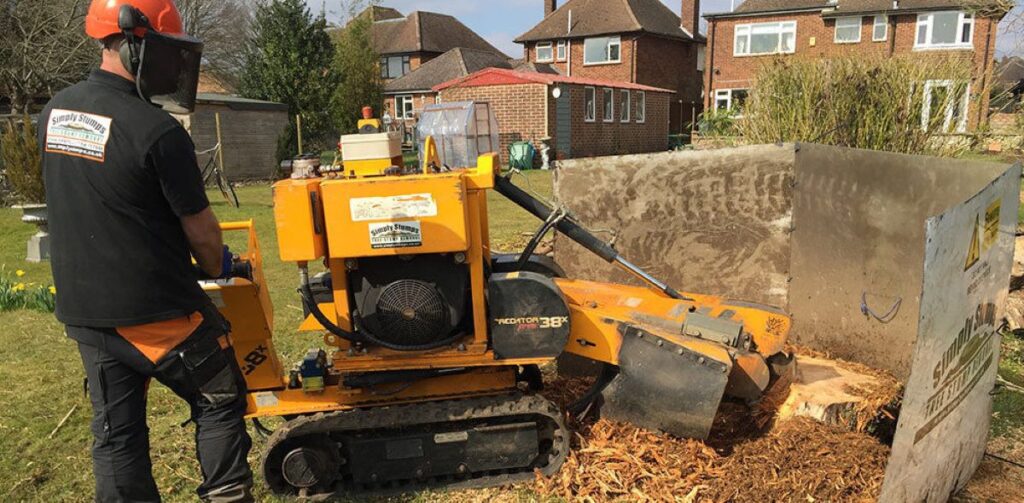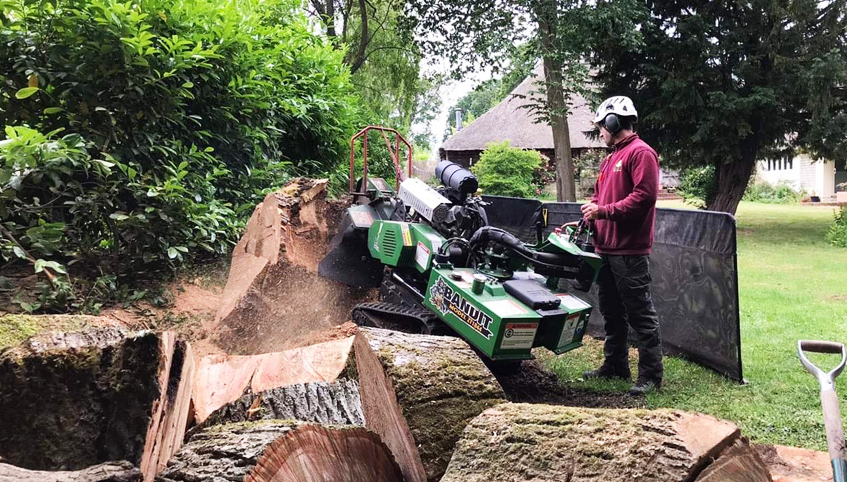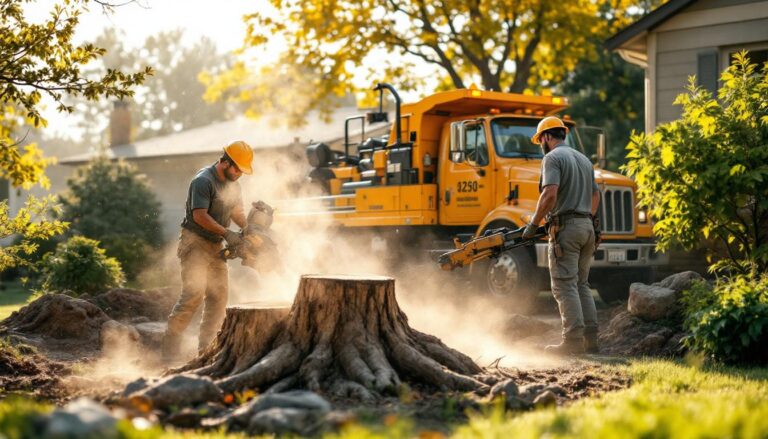Tree stumps can be an eyesore in any garden or landscape, often hindering the aesthetic appeal and usability of outdoor spaces. Grinding large tree stumps is a practical solution that not only enhances the visual aspect of your property but also facilitates future landscaping projects. This guide delves into the intricacies of stump grinding, outlining what to expect from the process, the benefits it offers, and essential considerations to keep in mind.
Understanding Stump Grinding
Grinding large tree stumps is the process of removing tree stumps by using a specialised machine known as a stump grinder. This equipment grinds the stump down into small wood chips, effectively eliminating the visible part of the tree while leaving the roots underground. The process is efficient and can be completed relatively quickly, depending on the size of the stump.
Unlike stump removal, which involves digging out the entire root system, stump grinding focuses solely on the visible portion of the stump. This method is less invasive and can be less disruptive to the surrounding landscape, making it a preferred choice for many homeowners and landscapers.
The Stump Grinding Process
The process of stump grinding typically involves several steps, each crucial for achieving a clean and effective result. Initially, the area around the stump is cleared of debris and any surrounding plants to ensure safe access for the grinder. Once the area is prepared, the stump grinder is positioned over the stump, and the grinding begins.
The grinder’s rotating blades chip away at the stump, gradually reducing it to mulch. This mulch can be left on-site for use in gardens or landscaping, or it can be removed if desired. The depth of grinding can vary, but it is generally recommended to grind the stump at least 15-30 cm below ground level to prevent regrowth and allow for easy replanting.
Equipment Used in Stump Grinding
Stump grinders come in various sizes and types, ranging from small, portable models suitable for residential use to large, heavy-duty machines designed for commercial applications. The choice of equipment often depends on the size of the stump and the accessibility of the location. For instance, smaller grinders can easily navigate tight spaces, while larger models are more efficient for bigger stumps.
Professional stump grinding services typically use high-powered machines that can grind stumps quickly and effectively. These machines are equipped with sharp, durable blades that can handle even the toughest wood, ensuring a thorough job. If you choose to rent or purchase a stump grinder, it’s essential to familiarise yourself with its operation and safety features to avoid accidents.
Benefits of Stump Grinding
Grinding tree stumps offers numerous benefits that extend beyond mere aesthetics. One of the primary advantages is the prevention of pest infestations. Tree stumps can attract insects such as termites and beetles, which may eventually spread to nearby trees and structures. By grinding the stump, you significantly reduce the risk of these pests taking residence in your garden.
Additionally, stump grinding allows for better utilisation of the space. Once the stump is removed, you can easily replant grass, flowers, or even new trees in the area. This not only enhances the beauty of your landscape but also increases the overall value of your property.
Environmental Considerations
Stump grinding is considered an environmentally friendly option compared to traditional stump removal methods. By grinding the stump into mulch, you can recycle the wood and use it as organic matter in your garden. This mulch can help retain moisture in the soil, suppress weeds, and provide nutrients as it decomposes.
Moreover, stump grinding minimises soil disruption, allowing the surrounding ecosystem to remain intact. Unlike excavation, which can disturb the root systems of nearby plants, stump grinding is a more sustainable choice that promotes healthy soil and plant growth.
Cost of Stump Grinding
The cost of stump grinding can vary significantly based on several factors, including the size and number of stumps, the complexity of the job, and the location. On average, homeowners can expect to pay between AUD 100 to AUD 300 per stump, with larger stumps potentially costing more due to the increased time and effort required.
It is advisable to obtain quotes from multiple service providers to ensure you receive a fair price. Some companies may offer package deals if you have multiple stumps to grind, which can help reduce overall costs. Always inquire about any additional fees, such as those for removing the mulch or for travel, to avoid surprises on your final bill.
Preparing for Stump Grinding
Preparation is key to a successful stump grinding experience. Before the grinder arrives, ensure that the area around the stump is clear of any obstacles, including rocks, plants, and garden furniture. This not only facilitates easier access for the equipment but also ensures the safety of those involved in the process.
It is also advisable to mark any underground utilities, such as gas or water lines, to prevent accidental damage during grinding. Many local councils offer utility marking services, which can provide peace of mind and ensure compliance with safety regulations.
What to Expect During the Process
During the stump grinding process, you can expect some noise and vibration as the machine operates. Stump grinders can be quite loud, so it may be wise to inform neighbours in advance, especially if you live in a densely populated area. Additionally, the grinding process can create a considerable amount of wood chips and dust, so wearing protective eyewear and a dust mask is recommended.
The duration of the grinding process will depend on the size of the stump and the efficiency of the equipment. Generally, a single stump can be ground within 30 minutes to an hour. Once the job is complete, the area will be left with a pile of mulch, which can be used in your garden or removed as per your preference.

Post-Grinding Care
After the stump has been ground, there are a few steps to consider for optimal post-grinding care. If you plan to replant in the area, it is advisable to allow the mulch to settle for a few weeks before planting. This will ensure that the ground is stable and ready for new growth.
Additionally, monitor the area for any signs of regrowth. While stump grinding significantly reduces the chances of a tree sprouting again, some species may still attempt to regrow. If you notice any new shoots, they should be removed promptly to prevent them from developing into a new tree.
See Also : Stump Grinding Services Near Me: Reliable Local Solutions
Landscaping After Stump Grinding
Once the stump has been ground and the area is prepared, you can begin to think about landscaping options. The mulch left behind can be spread around the area to create a natural look, or it can be removed to allow for new planting. Consider incorporating flowers, shrubs, or even ornamental grasses to enhance the beauty of your garden.
If you’re unsure about what to plant, consulting with a local landscape designer can provide valuable insights. They can help you choose plants that will thrive in your specific environment and complement your existing landscape.
Conclusion
Grinding large tree stumps is a practical and efficient solution for homeowners looking to improve their outdoor spaces. By understanding the process, benefits, and preparation involved, you can ensure a smooth experience and achieve the desired results. Whether you choose to hire a professional service or tackle the task yourself, stump grinding can significantly enhance the aesthetics and functionality of your garden.
With the right approach and care, you can transform an unsightly stump into a beautiful area ready for new growth and landscaping opportunities. Embrace the potential of your outdoor space and enjoy the benefits that come with a well-maintained landscape.


